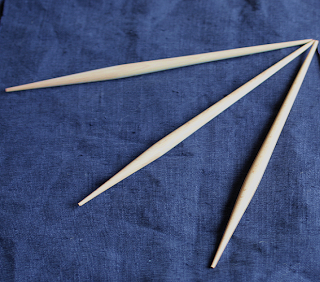Search the Blog
Latest Comments
Back to earth.
The Abysmally Underestimated and Neglected Spindle Stick!
While spindle-whorls are common archaeological finds, and while there are hundreds of dozens of spindles in all kinds of homes, working or not, the spindles themselves - that is, the sticks - are not something commonly seen for sale on markets. And I asked myself: Why? While there are not so many conserved wooden spindle sticks (I could write just "spindle", but I want to prevent any misunderstandings) around, the situation is still much better than that on textiles. And there are textiles on any medieval event.
I found out soon why they are not commonly for sale. Medieval spindles are usually rather slender with a double-conical form. With as little as two or three millimetres diameter at the ends, and not much more than a centimetre at the thickest place, they are too slim to be turned on just any lathe - the thin stick starts to wobble, making an efficient production difficult or impossible. But spinning with a much thicker double-conical spindle stick, which would pose no problems when turning, will not work as well. And, even more important, that stick won't fit the whorls so smoothly. And you want your spindle to fit your whorls, all of them, so you can just change. For example, have three spindle sticks, spin on one until it's full, spin on the second until it's full, and then ply both singles together on the third stick before removing your ball of plied yarn from that spindle, freeing all three again. And that will work only if you can change your whorl from spindle stick to spindle stick - and preferably, if you have more than one whorl, this would work with any of your stash.
In contrast, most modern spindles are seen differently, with the whorl and the spindle stick firmly belonging together. And most spindle makers just have their own method that will cut out the need for double-conical spindle sticks - often they use a stick that is firmly fixed to the whorl and not conical in shape. So the market for spindle sticks seems to be not so large. And if you want just one single stick, you can always take a knife and whittle it down to fit your whorl(s). If you are like me, that is possible yet not pleasing, because I'm not so good a whittler, and most of my "make a spindle" efforts were not so successful. Whittling down some wood to get a rounded, conical and slender shape is not too easy, I found.
So after searching a while, I finally found a workshop that accepted the challenge. And now they are back: Double-conical spindle sticks, made from beech wood, modeled after a find from Bergen in Norway. They are 11 mm thick at the fattest part, 3 mm at the ends, and 27 cm long. Need I say they are a pleasure to spin with?

Comments 3
There are not many spindles in market stalls because not so many reenactors can spin and Find it pleasing (despite spinning was necessary in period and thus common - which is obvious).
And that's why I had to make my own spindle :-/
(You know the story...).
So I'm glad you shared the idea and developing it.
Kruliczyca, I know of several stalls selling spindles or spindlewhorls, it's just the spindle sticks that are never to be seen.
Louise, I hadn't planned on carrying whorls as well, because it's the stick that is the problem, and I figured that most people would already have a favourite whorl or five. And a second reason: there's already a stall selling spindles and fibres in my circle of friends, and I don't want to poach on her territory - my intention is to just fill the gaps. But who knows, maybe I'll make or get some whorls in addition to the spindles.



